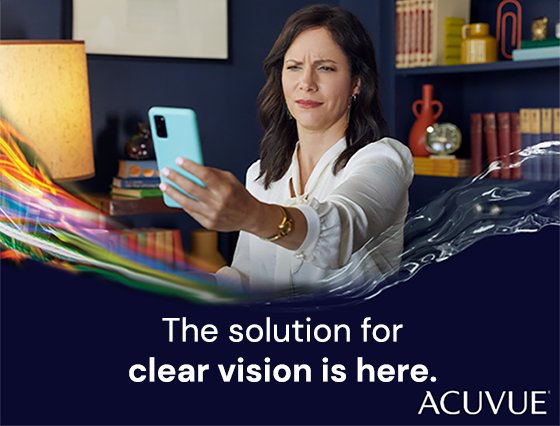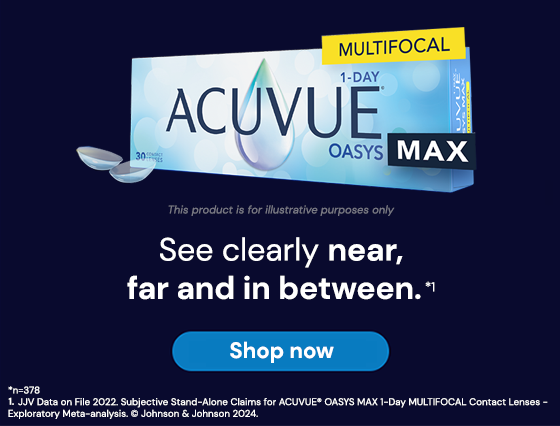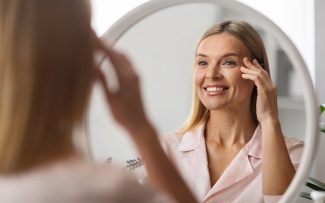6 simple ways to protect your eyes as you age
Our eyes change with age — that’s just a fact. But there’s a lot we can do to slow down the process and preserve our vision.
To help keep a youthful outlook, our in-house optometrist, Roshni, shares some simple steps to protect our eyes as we age.
How do our eyes change over the years?

Birth to teenage years
Our eyes develop the most during the first two years of our lives, with another growth spurt during our teenage years. By the age of twenty, the eyes are fully grown and most people know if they require corrective eyewear.
Age 40+
From around the age of forty, many adults find it tricky to focus on close-up objects. This is because the lens inside the eye becomes less flexible with age — a common process called presbyopia. It’s nothing to worry about and can be easily corrected with multifocal contact lenses. However, some people experience more serious age-related eye diseases, such as:
- Cataracts are the clouding of the eye’s lens (the transparent disc inside your eye). Over time, these cloudy patches get bigger causing blurry vision. They are very common in people over 60 and can almost always be removed with surgery.
- Glaucoma is a group of eye diseases that damage the optic nerve — the bit that connects your eyes to your brain. It tends to develop slowly over the years and affects the edges of your vision first. Many types of glaucoma have no early signs or symptoms and are often only detected during a routine eye test.
- Age-related macular degeneration (AMD) affects your central vision and your ability to focus on detail. It’s caused by the gradual breakdown of the cells at the back of your eye (the macula). Macular degeneration isn’t painful, but it’s the leading cause of sight loss in the UK.
Other more subtle changes in our vision include:
- Need for more light. Our pupils get smaller as we age, making it difficult to see in low light. Adding bright lights to office spaces or snug areas will make reading more comfortable.
- Sensitivity to glare. Changes in the eye’s natural lens cause light to scatter and create more glare.
- Changes in colour perception. Gradual yellowing of the lens can dull the vibrancy of colours and make it tricky to distinguish between certain shades.
- Dry eyes. Our body produces fewer tears as we age, which can cause our eyes to become dry and sore. The most effective way to minimise dry eye is to use artificial tear drops and apply a warm compress to your eye.
While some of these changes are genetic, others are exacerbated by external factors, like screens, smoking or sun damage.

Steps we can take to slow down the process
Kick the smoking
Tons of research has confirmed the harmful effects of smoking on eyesight. In fact, smokers are twice as likely to lose their sight from eye diseases, such as cataracts and AMD, compared with non-smokers. Avoiding smoking is one of the best things we can do to protect our vision.
Get regular check-ups
Even if you’re blessed with 20/20 vision, you should visit your optician once every two years. Why? Well, an eye test does more than measure how well you can see. It can reveal early signs of eye conditions and also detect health problems, like diabetes, high blood pressure and cardiovascular disease.
Take a break from screens
Screens emit a lot of blue light, which can cause our eyes to become dry, tired and irritated. You don’t have to avoid screens altogether, but there are some simple ways to prevent eye strain. Try following the 20/20/20 rule (every 20 minutes, take a 20-second break, to focus on something 20 feet away) or track your daily usage with handy apps like ‘Moment.’
Stay active
Regular exercise has heaps of benefits for our whole body, and that includes our eyes, too. Studies have shown that being active can help reduce the risk of developing eye conditions. It also helps avoid health problems, like high blood pressure and diabetes, that may indirectly damage our eyes. And you don’t need to be a professional athlete to reap the benefits. A jog in the park, a gentle yoga class or a few lengths of your local pool, all provide excellent benefits.
Tuck into a healthy diet
Incorporating a rainbow of fresh fruit and veg into our diets can help to protect our eyes from age-related conditions. Berries, nuts, dark leafy greens, dark chocolate (not the sugary stuff) and oily fish, all have great benefits.
Protect your eyes from the sun
Long-term exposure to sunlight can increase the risk of health problems, including cataracts, temporary eye burns, and even skin cancer. While our sunglasses are usually reserved for warm summer days, sun damage can occur year-round – even on a cloudy autumn day. Invest in a reliable pair of shades that block out at least 99% of both UVA and UVB.
Want more on eye health? Head over to our Vision Hub, packed with expert advice on everything from exercising in lenses to caring for your contacts.



